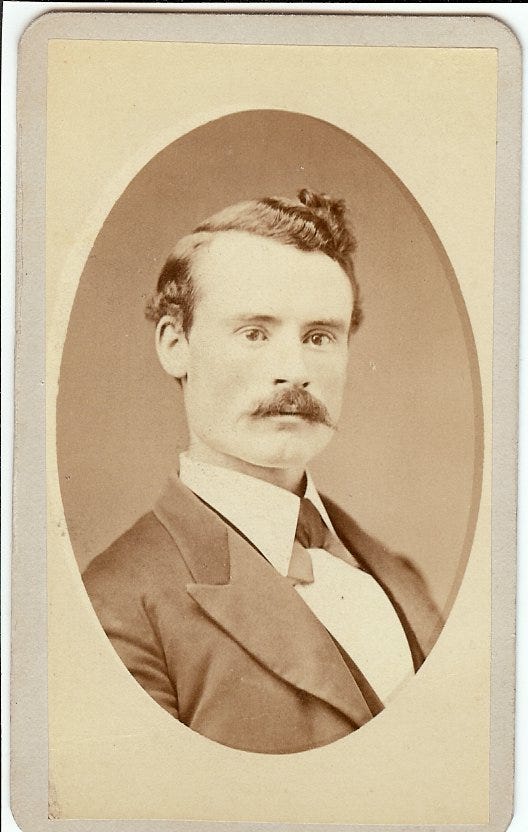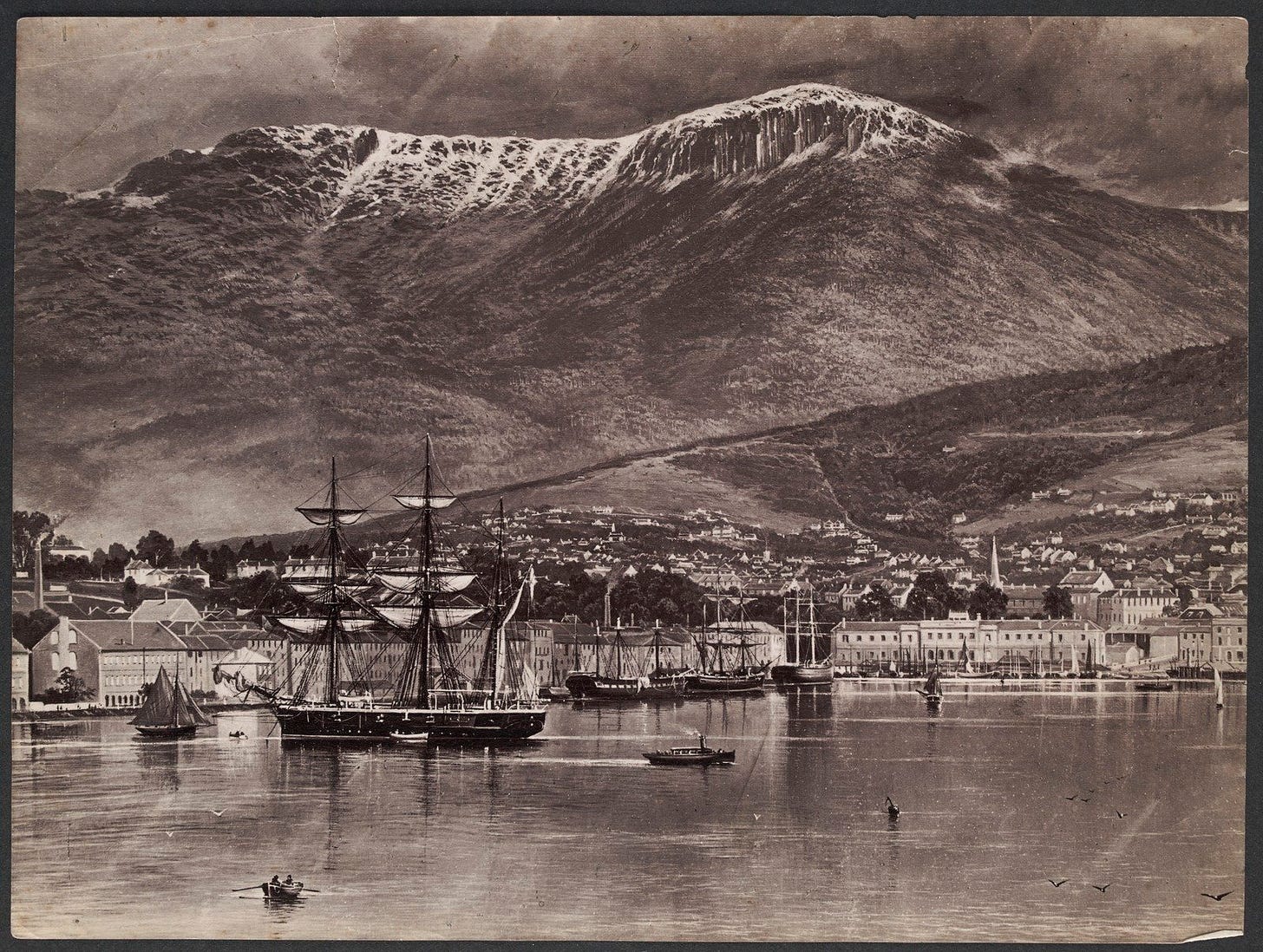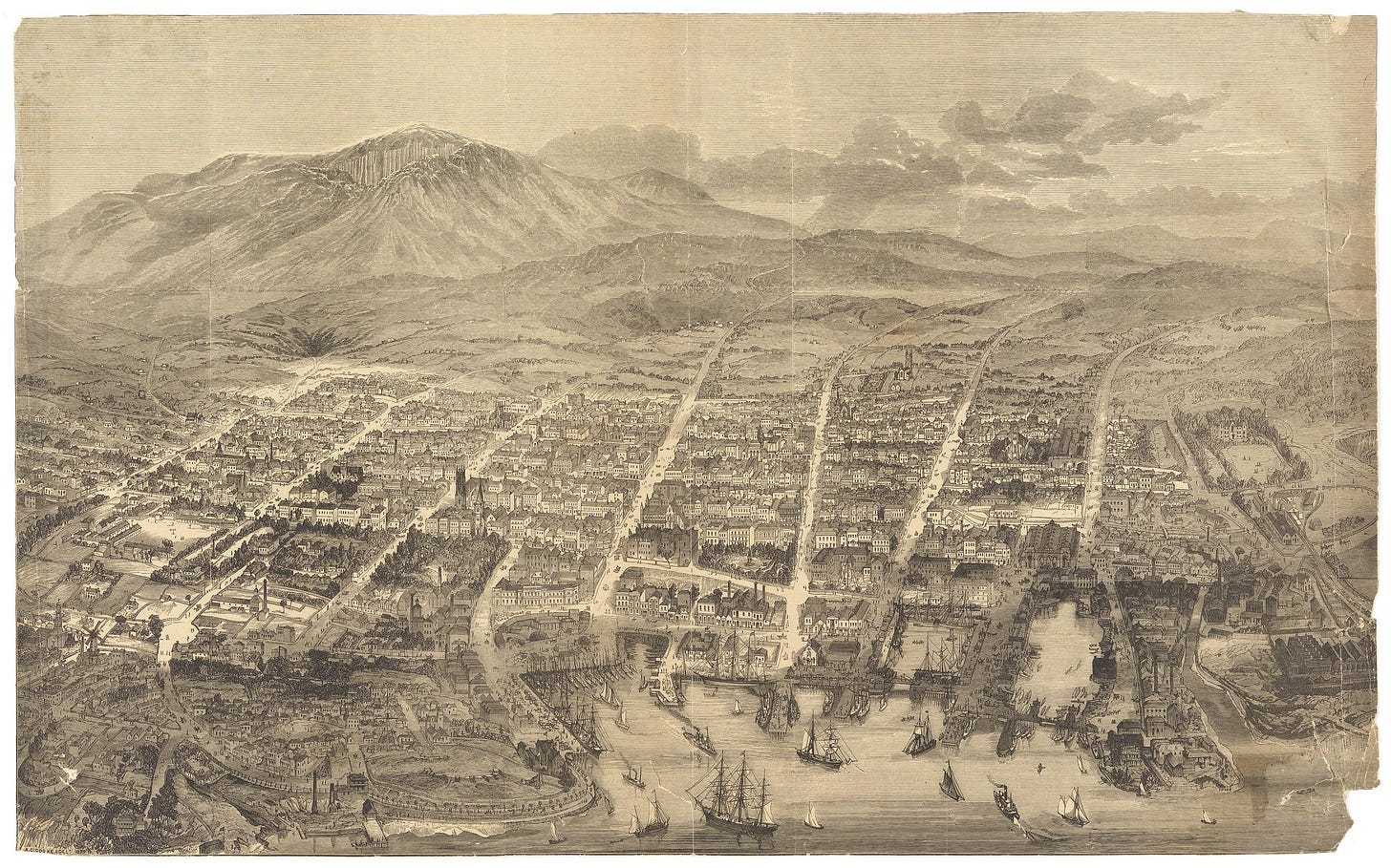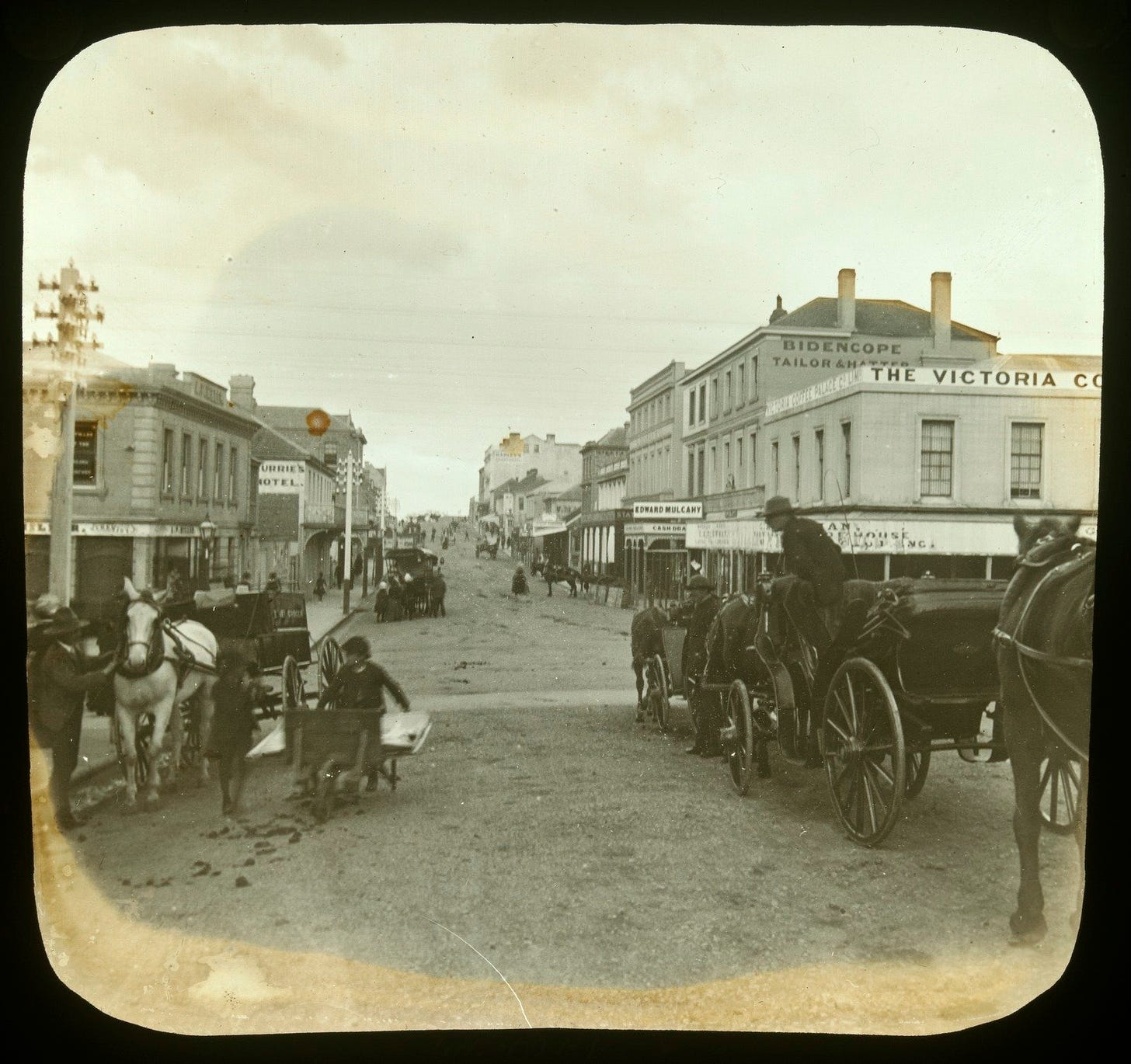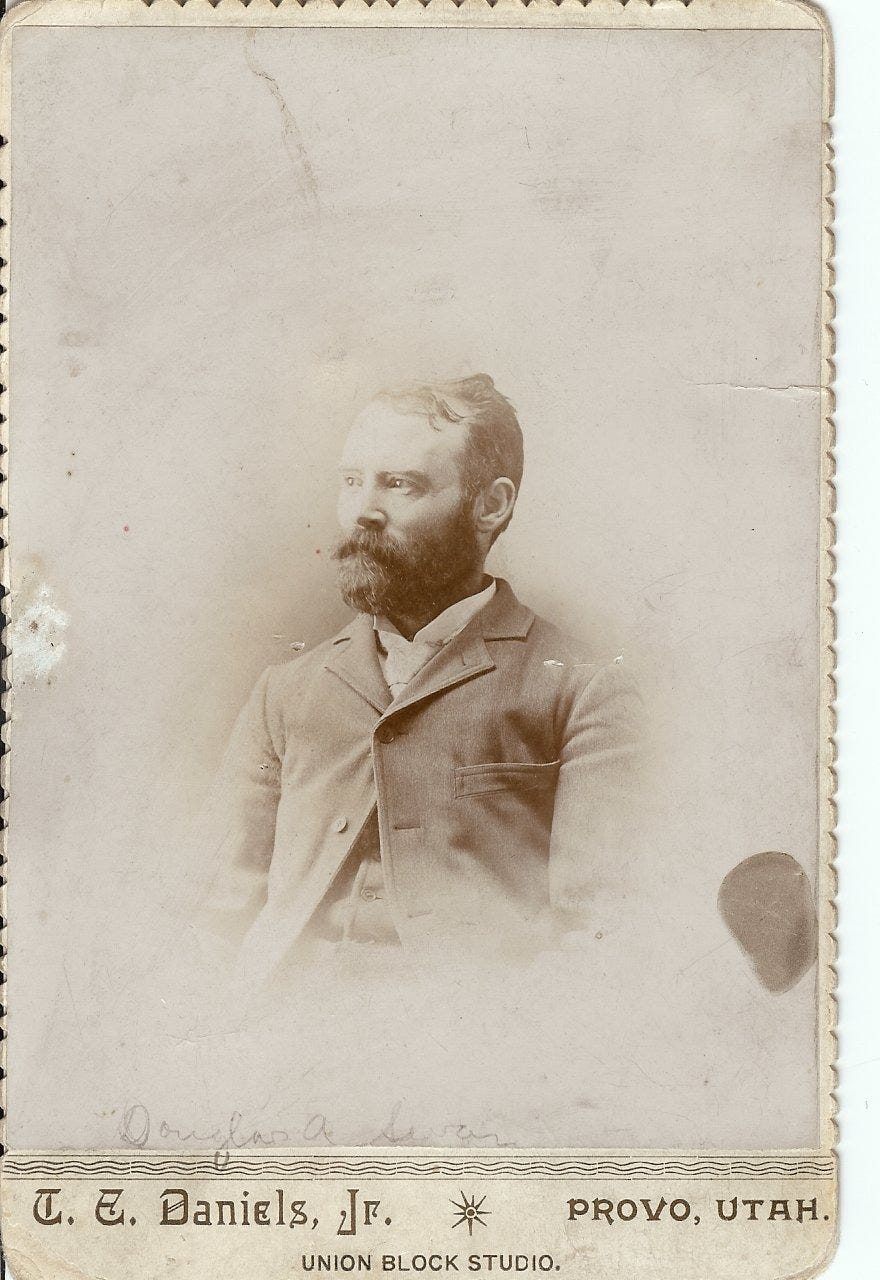"He is finally on the brink of the water"
Douglas Swan's efforts to share his faith in Tasmania
In November 1875, Douglas Swan was a young twenty-six-year-old on his way to Australia to serve as a missionary for The Church of Jesus Christ of Latter-day Saints. The Scottish native had been baptised at age eight in Edinburgh, Scotland, and emigrated with his mother in 1862. His parents had been baptised in 1842 and so he had been raised with the gospel in his life. In Utah he had several jobs before he was called on his mission. Now he was in Honolulu, Hawaii, waiting for his ship to be provisioned for the next stage of its journey. While there he walked around the port taking in the sites, sounds, and daily doings of the city. At one point he went into a large sugar warehouse on the dock where he saw people working.
Douglas could not believe his eyes. Different grades of sugar had been spread onto the floor. With bare and dirty feet, the workers walked over the sugar mixing it together with shovels. One of them smoked a pipe as he worked and now and then would take it out and squirt a mouthful of tobacco juice onto the sugar. Horrified, he soon left the warehouse vowing never to consume sugar from Hawaii again. Douglas’ journey from America to Australia continued to be eventful with storms, broken equipment, fishing for sharks, and other close accidents.
Soon after arriving in Sydney, Douglas was assigned to labour in Hobart, Tasmania, with fellow missionary Charles Burton, and they wasted no time in heading there. They arrived in Hobart which would remain their hub and principal area of proselyting for the entirety of their stay. The island only had a population of 100,000 people with Hobart being the largest settlement.1 After their arrival they made some arrangements for accommodation and quickly set to their work by renting the Odd Fellows Hall for Sunday meetings, despite having no established congregation. They were now 600 miles away from the nearest missionary and had no one to help them. To announce their arrival and purpose they paid for adverts in newspapers which announced “Missionaries from Utah” would be preaching that Sunday and invited the public to attend.
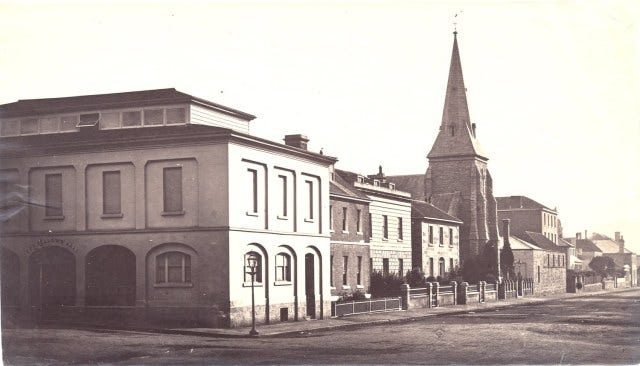
Their first Sunday (23 January 1876) saw a crowd of 200 people gather to listen to the missionaries with many people collecting tracts until there were none left. The meeting also helped identify some old time members who had moved to Hobart and lost touch with the Church. Douglas made a note of one of those who came up to him:
Among those who came to the stand was an old man by the name of Speakman who said he had belonged to the church many years ago, that he had been a priest & had preached a great deal until he had found a contradiction in the book “Doctrine & Covenants” & he had then left the church. He wanted to know if we had that book with us & said he would like to talk to us on the subject. I told him we had the book & would be glad to talk with him at any time he would appoint either at our lodgings or his house. But no, he said, “We will have it out in public.” I told him we didn’t come to discuss in public with anyone, that personally I didn’t approve of public discussion but if we could explain it to his satisfaction we would be pleased to do so. He went off saying he would see about it or something to that effect.2
That “Speakman” was Thomas William Speakman who had been born in Scotland in 1811 and had been a committed Latter-day Saint missionary in the British Isles. He and his wife had joined the Church in Norwich in the 1840s. Emigration records showed that in 1855 he and his wife, Sarah, left Liverpool with their children bound for Tasmania. They recorded their religion as Baptist and worked in relatively low paid positions.
As the missionaries met some old time members they also tried to understand what missionary work had previusly taken place. Douglas had learned that three missionaries had visited Tasmania in 1853 when it was known as Van Diemen’s Land. However, nothing could be discovered about the impact of their visit. As he continued his enquiries he soon learned that the island has been under martial law in 1853 and it seems as if public meetings could not be held. In 1874 William Geddes, then the president of the Australasian Mission, had visited Tasmania and baptised a family, the Greens. While in Hobart he had also preached at the Oddfellows’ Hall.3 Douglas and his companion were the first missionaries to be stationed on the island since President Geddes’ visit and lived with the Greens.4 Over the years, families and individuals, such as the Speakmans, had moved to Tasmania as part of the wider migrations that were taken place in the nineteenth century.
In the days after the service newspaper articles appeared detailing the missionaries arrival, their first service, and would contintue to pass comment periodically over the ensuing months.5 On 26 January 1876, Douglas met William Speakman, the son of the man who had approached the missionaries their first Sunday. He had been baptised in Scotland shortly before his family left the Church and was now living in Hobart working as a baker on Murray Street. William explained that he believed in the principles of the gospel, but his father had been unable to understand or reconcile himself to polygamy. This impasse had prevented other family members from living their faith.
The following Sunday Thomas Speakman was in attendance again. Douglas recorded the following in his journal:
After the meeting was dismissed, the old man Speakman who had occupied a seat near the front came up in a great hurry & said that we had expressed ourselves willing to answer questions & why didn’t we give him a chance to ask some before dismissing the meeting? I replied that if he wished to ask any that we were still there to answer him. That didn’t suit him but he asked if we had a Doctrine & Covenants. We said “Yes.” Charley found one & he then endeavored to find some passage in it & after searching awhile gave it up & went off.
Before long, Douglas discovered that the Speakmans belonged to the ‘Campbellite faith’, which is more appropriately and better known as the Disciples of Christ movement. It was a Restoration movement that had emerged in earnest during the 1830s. It’s principal goal was to return to “primitive Christianity” and to reject non-Biblical teachings. Douglas recorded many such interactions with adherents of the faith:
The next night we had a visit from another member of the same church, a Mr. Poultenay, a young man. We discussed nearly the same questions with him as we had done the evening before with Davidson and on his leaving I lent him one of the catechisms that we brought with us from Sydney. We went part of the way home with him & he gave us a little idea of how they work in their church. It appears they have no particular head but appoint evangelists from their number. Also they appear to have no settled creed but the scriptures at large. He also told us about what Speakman’s character is with them for he belongs to them. It appears he is very quarrelsome & fanatical and is always introducing difficulties & new doctrines. He, Speakman, came to us today & wanted a tract & said that he could not let it alone & told us he was at variance with the sect he belonged to. Of course we gave him a tract but I don’t want him to come in & think to do with us as he does with them, for if that is his idea he will find he has made a mistake & it may cause some trouble, so that I am not at all anxious about his joining the church again at present.
Douglas found it difficult to work with Thomas Speakman and was hesitant to engage with him. In fact, Douglas showed a remarkable ability to avoid being drawn into open debates. He was often heckled in their meetings but would insist in finishing his address and would answer questions privately at the end. He knew people wanted to draw him into an open debate about polygamy and he wisely avoided making a public spectacle. However, while Douglas struggled with Thomas, he found William Speakman to be easy to talk to and good company. Over the following weeks and months they developed a close friendship through regular interactions. While Douglas appreciated this, he felt that the depth of William’s interest in the gospel should be deeper than it appeared to be:
This evening [13 March 1876] we went up to Speakman’s, took tea & spent the evening; indeed we didn’t get home until 11 o’clock. He seems to have taken right hold of the doctrines & is I believe only waiting for someone to lead out & be baptized & he will follow. He is one of those people who accept a thing more on faith than reason, for he can’t reason. If asked why he was going to join us he would answer “because he believed the principles to be true” & that would be all the answer that could be got out of him. I prefer a man who can give a reason for the hope that is in him but I suppose it takes all sorts of people to make up a kingdom. His wife is a pretty smart little woman & those principles that she does understand she sticks to tenaciously. She gave us quite a lecture on “adult immersion” as opposed to “infant sprinkling” totally unmindful of the fact that our belief was precisely the same as her own & that there could be no discussion between us on that subject. They have a very nice looking family of 3 boys & 3 girls, the oldest being 13 years.
Thomas had lived and served in the Norwich branch and would visit those who had been disciplined or identified as needing extra help. That service, however, didn’t seem to educate or help him to handle his own ability to be impatient with others. The trigger of his long-term inactivity was soon discovered when Douglas visited him just outside of Hobart town centre:
We went up this evening [23 March 1876] to see Mr. Speakman, Sr. who lives at the Cascades about 2 miles from Town. We had quite a chat with him & his wife. We learned that he joined the Church at Norwich in England in the time of Orson Spencer who married a Miss Winkfield [Wingfield] whose father built a church for the Saints at that place where there were between 200 & 300 of the Saints at that time. Speakman afterwards went to Paisley in Scotland & in the beginning of the year 1854 when the revelation on Polygamy came out as a “New Years gift” he opposed it; in fact flew right off the handle & blanketed the town with hand bills calling a meeting in which he brought forward this revelation & compared it with book of Doctrine & Covenants and denounced the Church at large. He also called a second meeting at which the President of the Branch & several others of the saints were present & when he got up to speak he found that he could not say a word – that his lips were sealed. He afterwards confessed his fault & was received back again into the Church & soon after came out here. Still says he does not believe in Polygamy & never will. His son went up there with us & we had quite a talk on the way back home.
Norwich branch records show that in July 1848, a Thomas Speakman had had his membership suspended for “rebelling against the council.”6 A year later there was a similar case. in which he was described as manifesting a “wicked” and “accusing” manner against other Priesthood members. His membership was again suspended and people were assigned to minister to him.7 At the next council meeting in June 1849 he was formally cut off from the Church. At some later he point he seemingly returned to the Church. There was, however, a pattern of behaviour that seemed to be forming wherein he had difficulties working with and listening to others. His son, William, did not seem to have the same challenge.
By invitation we went to Mr. Speakman’s [William] took tea & spent the evening. We had a very nice social chat on general topics & I came down to the room & got all the photographs we had including that of President Young with which they were quite delighted. Speakman saw us home & on the way proposed that we have our photographs taken in a group, adding that we could send them home by the next mail & by that time we might have some news to send with them, meaning of course in regard to his baptism. He is finally on the brink of the water but I think he would like to have Thornhill come with him. We will see what the result will be, things look hopeful.
As Douglas and his companion met with William they sought to build bonds between the various individuals in their orbit. For example, in April 1876 they arranged to have a group photograph before again spending more time with the Speakmans.
Friday, April 14, 1876 Good Friday. The shops are all closed and it is a general holiday all over the town. There are services in all the principle churches. This morning by appointment we went with Mr. Speakman to Winters, the photographer’s on Elizabeth Street and had our photographs taken. We had them taken singly and afterwards in a group. Went up and took dinner with Mr. Speakman.
While a friendship and gospel connection was struck with William, Douglas was unable to make much progress with the rest of the Speakman family.
Saturday, April 29, 1876 I haven’t written any this week, the time has gone so fast. On Monday I read. On Tuesday I went out to Newtown and distributed tracts. On Wednesday evening I went up to Speakman’s I think. On Thursday evening we were at Tea at Mr. Cook’s. On Friday I have forgotten where we went and on Saturday night we took a walk with Mrs. Green and on the way home met Mr. Crisp. Mrs. Green has been feeling very well this week after having made up her mind in regard to the principles. Speakman has appointed next to be baptized.
Finally, William Speakman had made the decision to be baptised, which was scheduled for 3 May 1876 and would be performed by Elder Swan. The Domain is public recreation land that would have been likely quiet and far enough away to hold a baptismal service to avoid it becoming a spectacle.
This evening [Wednesday 3 May 1876] about 7 o’clock Charley, Mr. Thornhill, Mr. Speakman and myself went down to the shore of the river in the Domain and I baptized Mr. Speakman. This is our first baptism and I pray God that he will increase the number in his own due time so that those who are earnest may be gathered out.
The River referred to was the River Derwent .
The following Sunday the missionaries and William Jnr. gathered together for what appears to be the first sacrament meeting in Tasmania.
This morning [7 May 1876] Brother Speakman came down to our room and we had a little Sacrament Meeting, the first that we have had since we came here. We each of us spoke a little and together we had a good time.
Throughout Douglas’ journal it was a regular occurrence for him to record going to William’s for a meal, to look at photographs, and to spend time in conversation. The missionaries’ arrival had also come at an opportune time in which the Disciples of Christ congregation was undergoing some internal strife. While Douglas didn’t celebrate the news, he also hoped that it would aid them in their work, but still it was slow and hard work to preach the gospel in Tasmania.
In the evening we went up to Brother Speakman’s & we all called up for a few minutes at Mr. Thornhill’s but didn’t stay long there. It appears there is a sort of a bustup in the “Christian Church” owing to some partisanship; some of the influential ones having made arrangements to have their old pastor back and the others don’t like it. Mrs. Speakman among the rest declares she will not go there any more if he comes back. I don’t know what will be the outcome but I hope it will help our cause at any rate.
As the year wore on and without seeing much success the mission president decided to withdraw missionaries from Tasmania. Douglas and his companion, Charles Burton, had spent their entire time together. In a service on 8 October 1876, Douglas announced during their weekly service that the two missionaries were to conclude their mission in Tasmania and would be leaving soon. Elder Swan was instructed to return home and Elder Burton was to continue his labours in Sydney.8 A summary of their final meeting recorded Douglas as saying that they:
…had met with much kindness whilst in Tasmania from some persons, and were exceedingly thankful to them. He concluded by hoping that the word preached by them and the doctrines incalcated might not all be lost.9
While the mission was not what had necessarily been expected, they had managed to baptise a number of local people and helped some who had formerly belonged to the Church to re-establish a connection to it and to call them to repentance. Their interactions with Thomas Speakman might have been frustrating and challenging, it brought them into contact with William Speakman and as a result bring him into the waters of baptism.
Statistics of the Colony of Tasmania for the year 1875 (Tasmania: James Barnard, 1876), p. 8.
Douglas Swan, journal, 23 January 1876
‘Southern Items,’ Launceston Examiner, 24 December 1874, p. 3.
Tasmania District general minutes, 1875-1876, LR 8968 11, bx. 1, fd. 2, CHL.
‘Mormon Missionaries in Hobart Town,’ The Mercury, 24 January 1876, p. 3; ‘Introductory,’ The Mercury, 20 March 1876, p. 1; ‘Untitled,’ The Mercury, 6 March 1876, p. 2; and ‘Local,’ Tribune, 12 September 1876, p. 2.
Record of Members Collection, CR 375 8, bx. 1982, fd. 2, item 152-Segment 2, CHL.
Record of Members Collection, CR 375 8, bx. 1982, fd. 2, item 171-Segment 2, CHL.
Tasmania District general minutes, 1875-1876, LR 8968 11, bx. 1, fd. 2, CHL.
‘Local,’ Tribune, 9 October 1876, p. 2.


